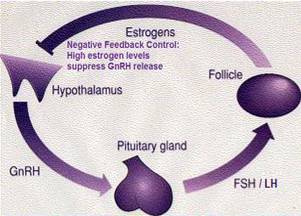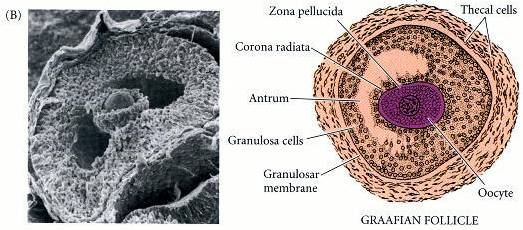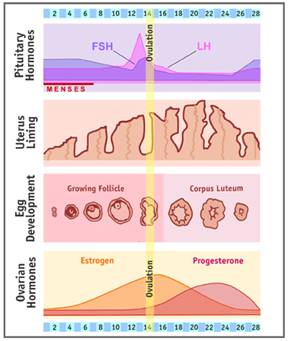(1)The ovaries (follicle granulosa cells) before ovulation (follicular phase) are the main source of estrogen (predominantly ESTRADIOL), which functions as a circulating hormone
(2) A small amount of estrogen is produced in peripheral tissue (E.g. skin, fat, muscle) by the conversion of circulating androgens (via aromatase enzyme)
(3)Theplacenta produces ESTRIOL during pregnancy
ESTRADIOL production is under the cyclical endocrine control of two PITUITARY gonadotrophins, LH and FSH - which are released by hypothalamic GnRH(which is subject to negative estrogen feed-back from the ovaries )
FSH/LH ▲ ➔ Estrogen ▲
Estrogen ▲ ▲ ▲ ➔ GnRH ▼ ➔ FSH/LH▼➔ Estrogen ▼
(Rising levels of estrogen in the blood begins follicle/egg development)

Luteinizing hormone (LH) -binds with LH receptors tostimulate follicle thecal cells to produce mainly ANDROSTENEDIONE,which is supplied to the neighboring follicle granulosa cells as a substrate with which to make ESTRADIOL;

Follicle-stimulating hormone (FSH)
The rise in ESTRADIOL causes expression of LH receptors ▲ on maturing follicles, which also indirectly increases ESTRADIOL▲ production. By stimulating theca cells to provide more substrate ANDROSTENEDIONE. ESTRADIOL continues its positive feedback loop supplying LH receptors for LH activation to provide more ANDROSTENEDIONE substrate for additional estrogenproduction, until high estrogenlevels inhibit hypothalamic GnRH,causing a decrease in FSH production and a subsequent decrease in estrogenproduction;

Normal, averageestrogen levels (measured in pg/ml) vary for a woman at different times throughout her reproductive years.
